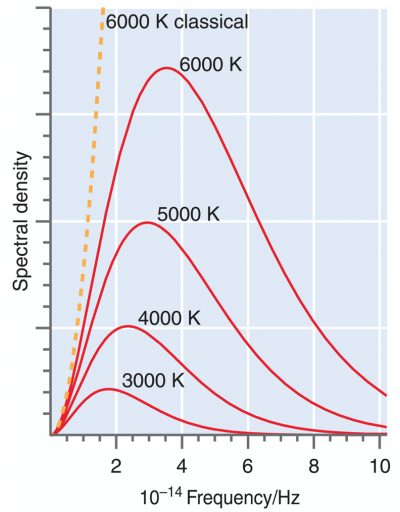Difference between revisions of "PChem322 s21 w1"
Jump to navigation
Jump to search
| Line 14: | Line 14: | ||
====Sec 1.3 Blackbody Radiation==== | ====Sec 1.3 Blackbody Radiation==== | ||
| − | [https://en.wikipedia.org/wiki/Planck's_law Plank's Law (Wikipedia)] | + | :[https://en.wikipedia.org/wiki/Planck's_law Plank's Law (Wikipedia)] |
| + | |||
| + | :- All objects are essentially "hot" (considering the concept of absolute zero). | ||
| + | :- All (hot) objects radiate light (electromagnetic radiation). | ||
| + | :- The wavelength/frequency of the light emitted from a (hot) object is related to the temperature of the object. | ||
| + | :- We can make a graph of wavelength (''λ'') or frequency (''ν'') as a function of temp (T), but at any given temperature light emitted has a range of ''λ'' or ''ν''. So instead we develop some expressions using the term spectral density (''ρ'' - rho). | ||
| + | |||
| + | [[File:Screen Shot 2021-01-27 at 9.18.22 AM.png|400px]] | ||
====Sec 1.4 The Photoelectric Effect==== | ====Sec 1.4 The Photoelectric Effect==== | ||
Revision as of 15:34, 27 January 2021
Monday Jan 25, 2021
- - Welcome
- - Attendance
- - Syllabus/Expectations
Weds, Jan 27, 2021
Chapter 1: From Classical to Quantum Mechanics
Intro, Sec 1.1, Sec 1.2
Read
Sec 1.3 Blackbody Radiation
- - All objects are essentially "hot" (considering the concept of absolute zero).
- - All (hot) objects radiate light (electromagnetic radiation).
- - The wavelength/frequency of the light emitted from a (hot) object is related to the temperature of the object.
- - We can make a graph of wavelength (λ) or frequency (ν) as a function of temp (T), but at any given temperature light emitted has a range of λ or ν. So instead we develop some expressions using the term spectral density (ρ - rho).
Sec 1.4 The Photoelectric Effect
Thurs, Jan 28, 2021
Meet in CSB 378
Activities
- - Laptop check (this course will require you to use Excel and Igor-more later, and maybe Mathematica and ZOOM.
- - Continue with Syllabus review...page 2, column 2...
- - Being Proactive vs. Reactive
